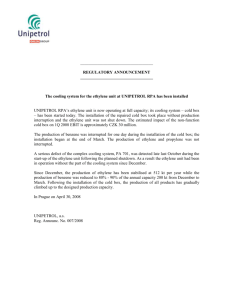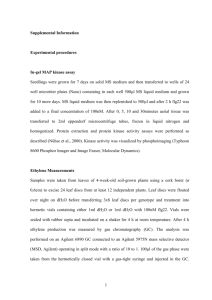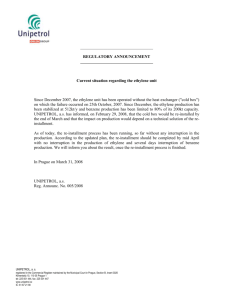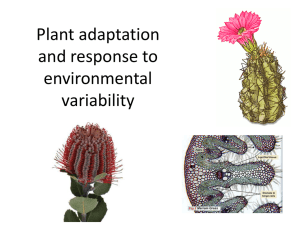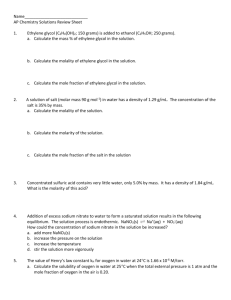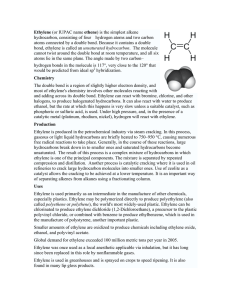Petrochemical Processes
advertisement
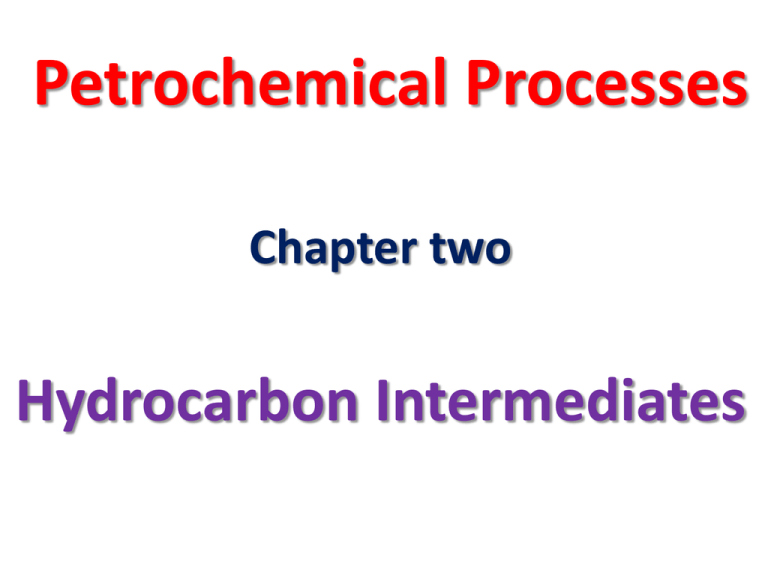
Petrochemical Processes Chapter two Hydrocarbon Intermediates Introduction Natural gas Crude oils Hydrocarbon intermediate Natural Gas Ethane LPG Refinery Gases Olefins LPG Petrochemicals Olefins Diolefins Paraffinic Hydrocarbons • Simple and heavier hydrocarbons (gasses, liquids and solids) are used to produce petrochemicals. • Relatively inactive compared to olefins, diolefins, and aromatics. • Few chemicals could be obtained from the direct reaction of paraffins with other reagents. • Precursors for olefins through cracking processes. • The C6–C9 paraffins and cycloparaffins are important for production of aromatics via reforming. Methane • • • • • • • • • • The main component of natural gas. By-product in all gas streams from processing crude oils. It is a colorless, odorless gas that is lighter than air. Not very reactive. No reaction with acids or bases under normal conditions. It reacts with oxygen and chlorine under specific conditions. Partial oxidation (O2, Heat and Catalyst) CO + H2 (synthesis gas) Synthesis gas is an important building block for many chemicals. Methane is a clean fuel gas. Important source for carbon black. Liquefied under very high pressures and low temperatures for transportation to long distances through cryogenic tankers. Ethane CH3-CH3 • Important intermediate for the production of olefins, especially ethylene. • Recovered from natural gas liquids. • Non-reactive. Partially oxidized to CO and H2 mixture. Chlorinated to produce ethyl chloride. Combusted in excess air CO2 + H2O (2 x that of CH4). • Burned with methane as a fuel gas. • Cracking ethylene (the largest end use of ethane) Propane (CH3-CH2-CH3) • More reactive paraffin than ethane and methane. • Obtained from natural gas liquids or from refinery gas streams. • Liquefied petroleum gas (LPG) = propane + butane and is mainly used as a fuel. • LPG is currently an important feedstock for the production of olefins for petrochemical use. • Liquid propane is a selective hydrocarbon solvent used to separate paraffinic constituents in lube oil base stocks from harmful asphaltic materials. • It is also a refrigerant for liquefying natural gas and used for the recovery of condensable hydrocarbons from natural gas. • Chemicals directly based on propane are few. • Only important when dehydrogenated to propylene for petrochemical use. • Propylene has always been obtained as a co-product with ethylene from steam cracking processes. Butane (CH3-CH2- CH2-CH3) • Obtained from natural gas liquids and from refinery gas streams. • The C4 acyclic paraffin consists of two isomers: n-butane and isobutane (2-methylpropane). The physical as well as the chemical properties of the two isomers are quite different due to structural differences. • Isobutene is more favorable gasoline additive to adjust its vapor pressure. • Isobutane, very reactive compound due to the presence of a tertiary hydrogen. • Butane is primarily used as a fuel gas within the LPG mixture. • Like ethane and propane, the main chemical use of butane is as feedstock for • steam cracking units for olefin production. Butane (CH3-CH2- CH2-CH3) • Dehydrogenation of n-butane to butenes and to butadiene is an important route for the production of synthetic rubber. • n-Butane is also a starting material for acetic acid and maleic anhydride production. • Due to its higher reactivity, isobutane is an alkylating agent of light olefins for the production of alkylates. • Alkylates are a mixture of branched hydrocarbons in the gasoline range having high octane ratings. • Dehydrogenation of isobutane produces isobutene, which is a reactant for the synthesis of methyl tertiary butyl ether (MTBE). This compound is currently in high demand for preparing unleaded gasoline due to its high octane rating and clean burning properties OLEFINIC HYDROCARBONS Ethylene CH2=CH2 • Ethylene (ethene), is a colorless gas with a sweet odor. Slightly soluble in water and alcohol. It is a highly active. • Addition of chlorine to ethylene produces ethylene dichloride (1,2dichloro-ethane), which is cracked to vinyl chloride. Vinyl chloride is an important plastic precursor. • Ethylene is also an active alkylating agent. Alkylation of benzene with ethylene produces ethyl benzene, which is dehydrogenated to styrene. Styrene is a monomer used in the manufacture of many commercial polymers and copolymers. • Ethylene can be polymerized to different grades of polyethylenes or copolymerized with other olefins. • Catalytic oxidation of ethylene produces ethylene oxide, which is hydrolyzed to ethylene glycol. Ethylene glycol is a monomer for the production of synthetic fibers. • Ethylene is a constituent of refinery gases Propylene CH2=CH-CH3 Like ethylene, propylene (propene) is a reactive alkene that can be obtained from refinery gas streams, especially those from cracking processes. The main source of propylene, however, is steam cracking of hydrocarbons, where it is coproduced with ethylene. There is no special process for propylene production except the dehydrogenation of propane. • Butylenes (butenes) are by-products of refinery cracking processes and steam cracking units for ethylene production. •Dehydrogenation of butanes is a second source of butenes. However, this source is becoming more important because isobutylene (a butene isomer) is currently highly demanded for the production of oxygenates as gasoline additives. •There are four butene isomers: three unbranched, “normal” butenes (n-butenes) and a branched isobutene (2methylpropene). The three n-butenes are 1-butene and cis- and trans- 2-butene. There are also addition reactions where both 1-butene and 2-butene give the same product. For this reason, it is economically feasible to isomerize 1-butene to 2-butene (cis and trans) and then separate the mixture. The isomerization reaction yields two streams, one of 2-butene and the other of isobutene, which are separated by fractional distillation, each with a purity of 80–90% An alternative method for separating the butenes is by extracting isobutene (due to its higher reactivity) in cold sulfuric acid, which polymerizes it to di- and triisobutylene. The dimer and trimer of isobutene have high octane ratings and are added to the gasoline pool. THE DIENES • Dienes are aliphatic compounds having two double bonds. • When the double bonds are separated by only one single bond conjugated diolefin • Nonconjugated diolefins separated (isolated) by more than one single bond. Less important. • An important difference between conjugated and nonconjugated dienes is that the former compounds can react with reagents such as chlorine, yielding 1,2- and 1,4-addition products. When polymerizing dienes for synthetic rubber production, coordination catalysts are used to direct the reaction to yield predominantly 1,4-addition polymers. BUTADIENE (CH2=CH-CH=CH2) • Important monomer for synthetic rubber production. It can be polymerized to polybutadiene or copolymerized with styrene to styrene-butadiene rubber (SBR). • Butadiene is an important intermediate for the synthesis of many chemicals such as hexamethylenediamine and adipic acid. Both are monomers for producing nylon. Chloroprene is another butadiene derivative for the synthesis of neoprene rubber. • Highly reactive and inexpensive. • Butadiene is obtained mainly as a co-product with other light olefins from steam cracking units for ethylene production. • Others, catalytic dehydrogenation of butanes and butenes, and dehydration of 1,4-butanediol. AROMATIC HYDROCARBONS •Benzene, toluene, xylenes (BTX), and ethylbenzene are the aromatic hydrocarbons with a widespread use as petrochemicals. •They are important precursors for many commercial chemicals and polymers such as phenol, trinitrotoluene (TNT), nylons, and plastics. •Aromatic compounds are characterized by having a stable ring structure due to the overlap of the π-orbitals (resonance). •Accordingly, they do not easily add to reagents such as halogens and acids as do alkenes. •Aromatic hydrocarbons are susceptible, however, to electrophilic substitution reactions in presence of a catalyst. •Aromatic hydrocarbons are generally nonpolar. They are not soluble in water, but they dissolve in organic solvents such as hexane, diethyl ether, and carbon tetrachloride.
